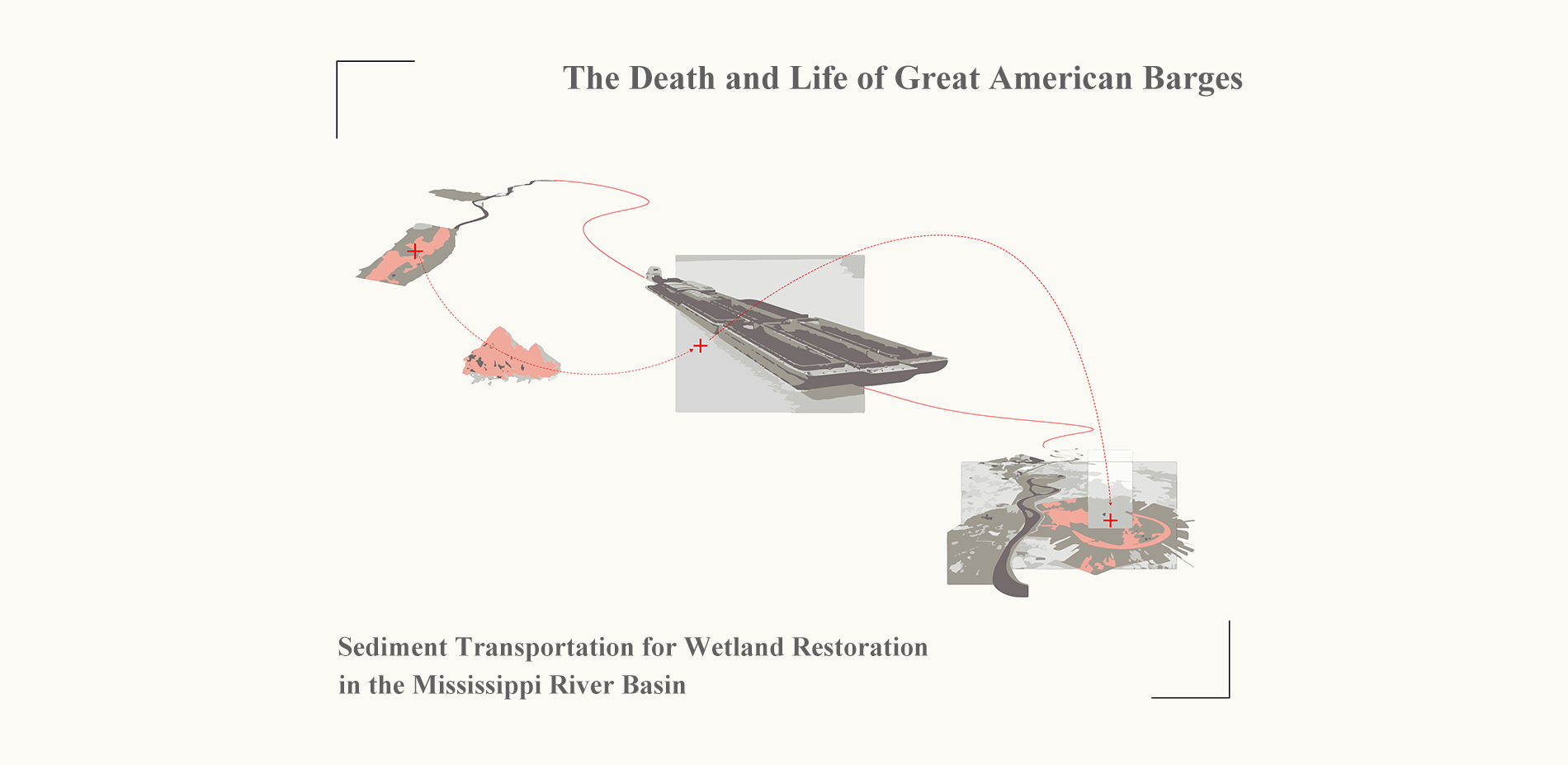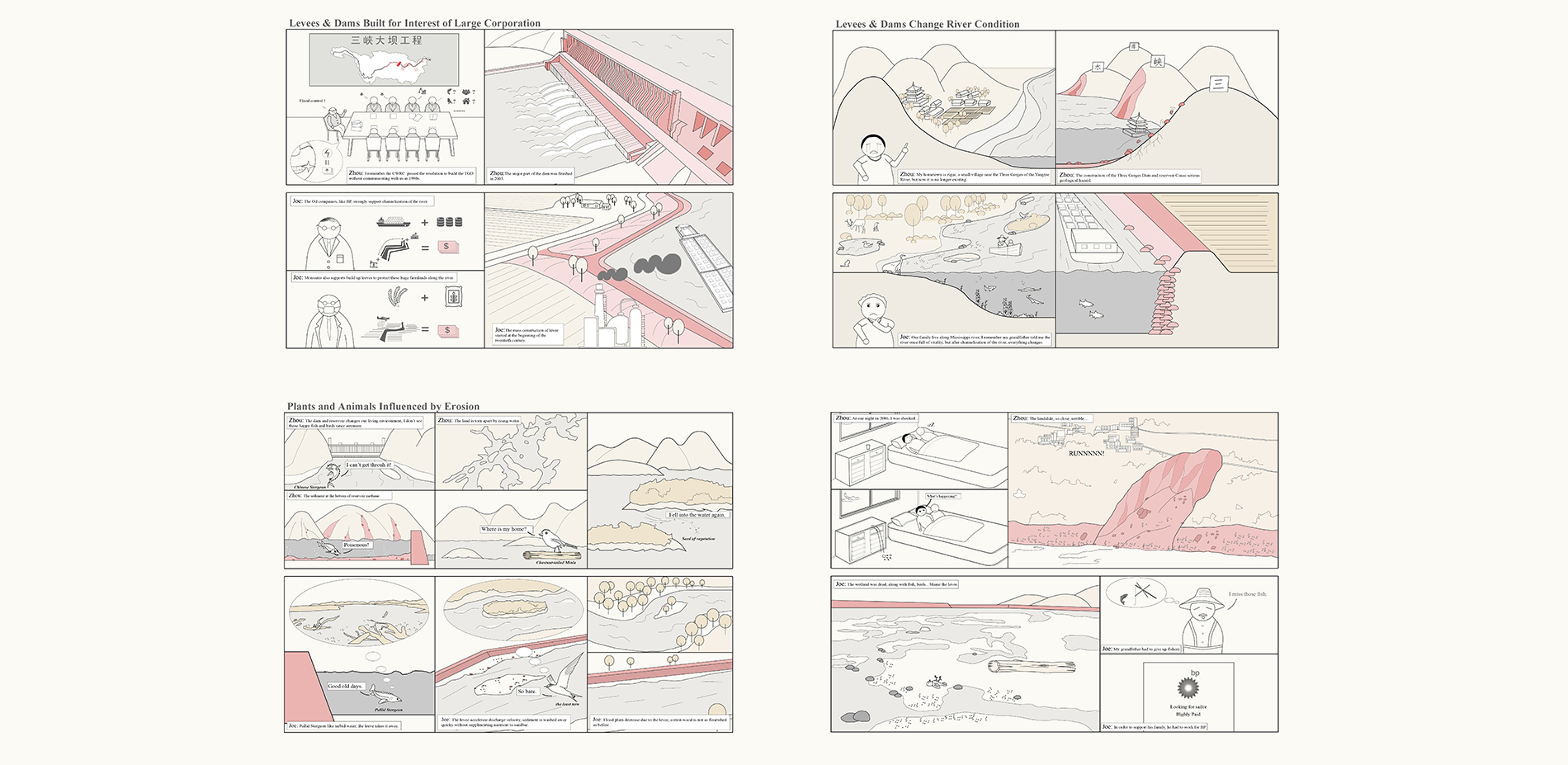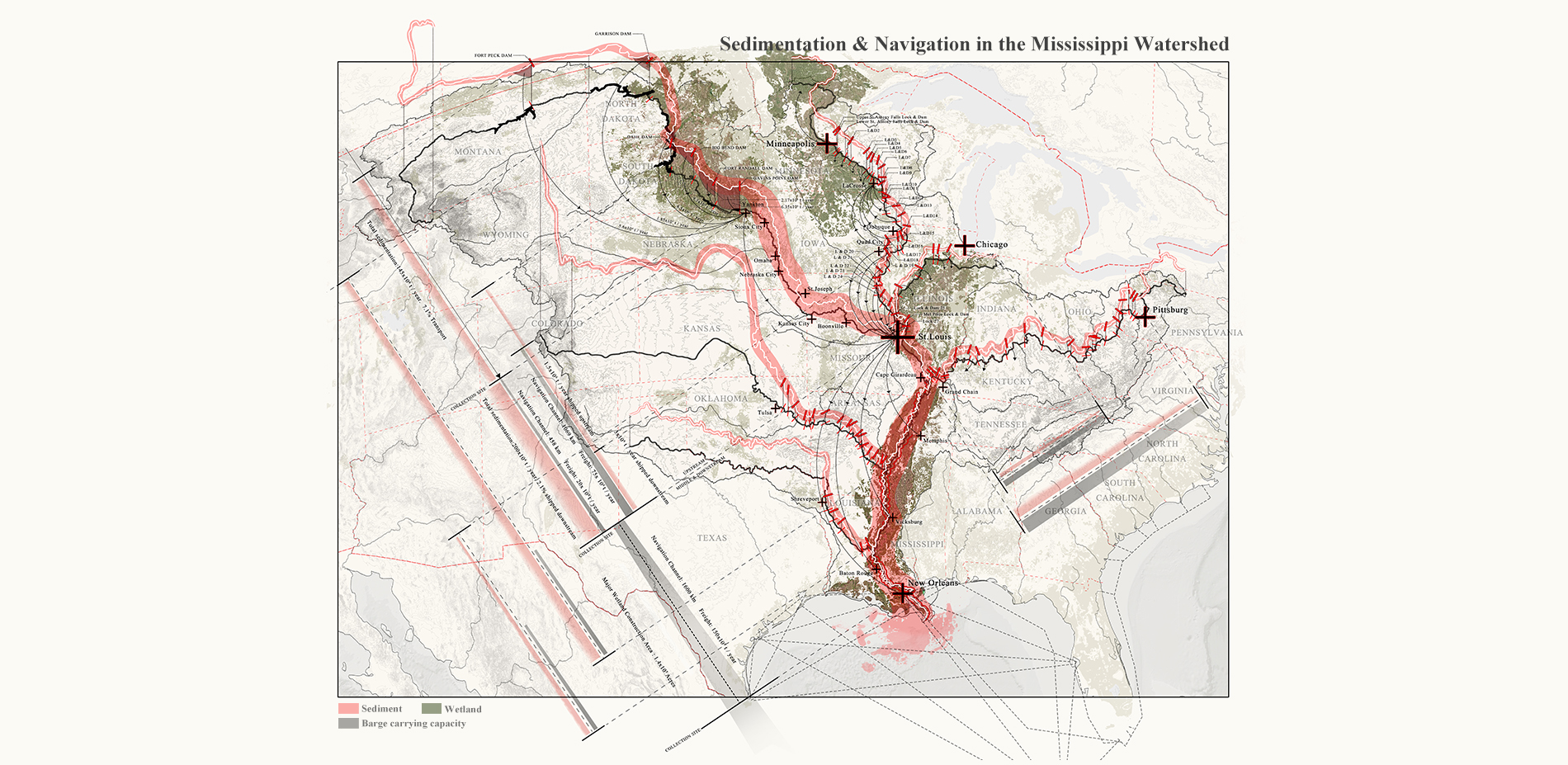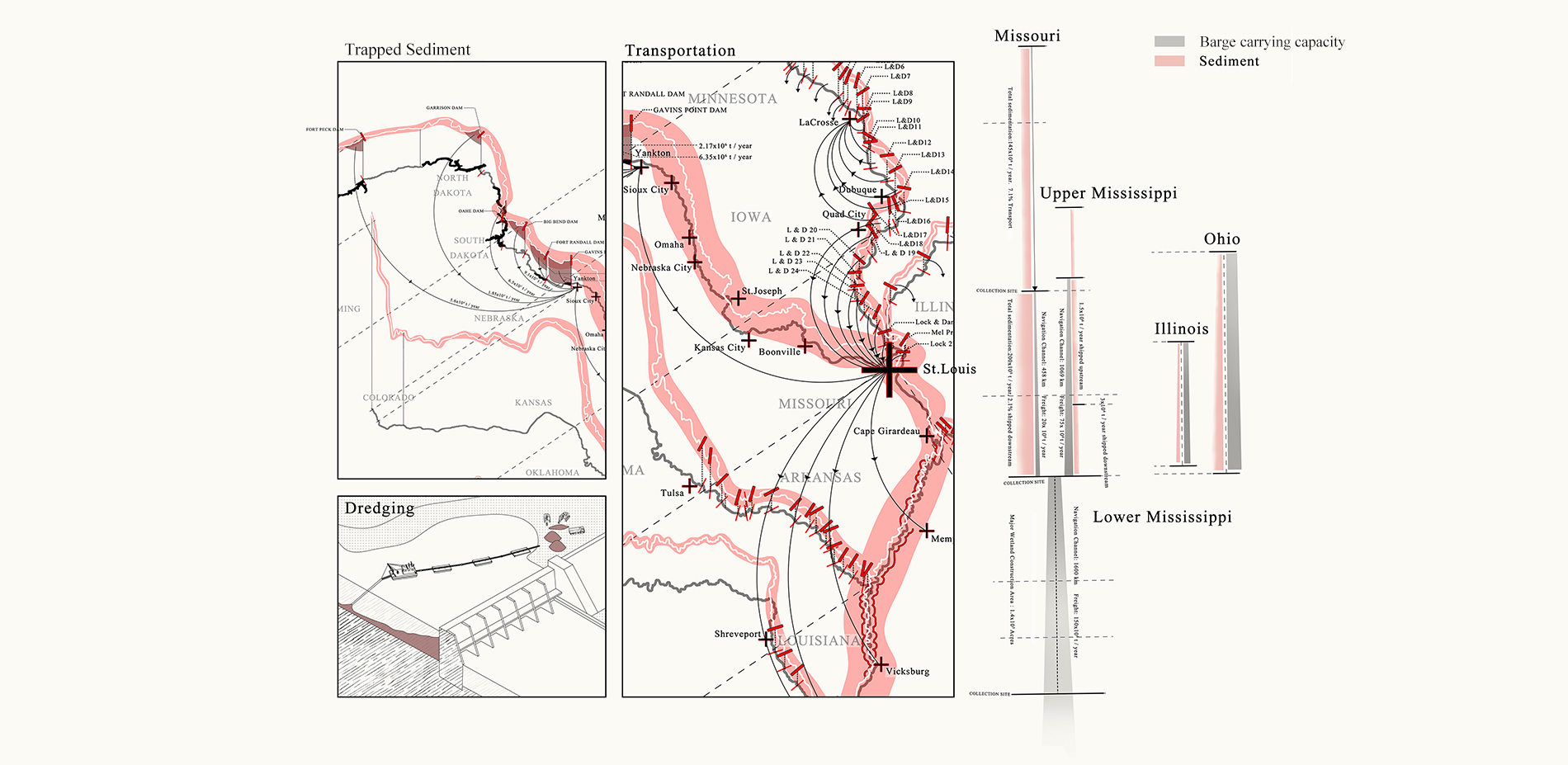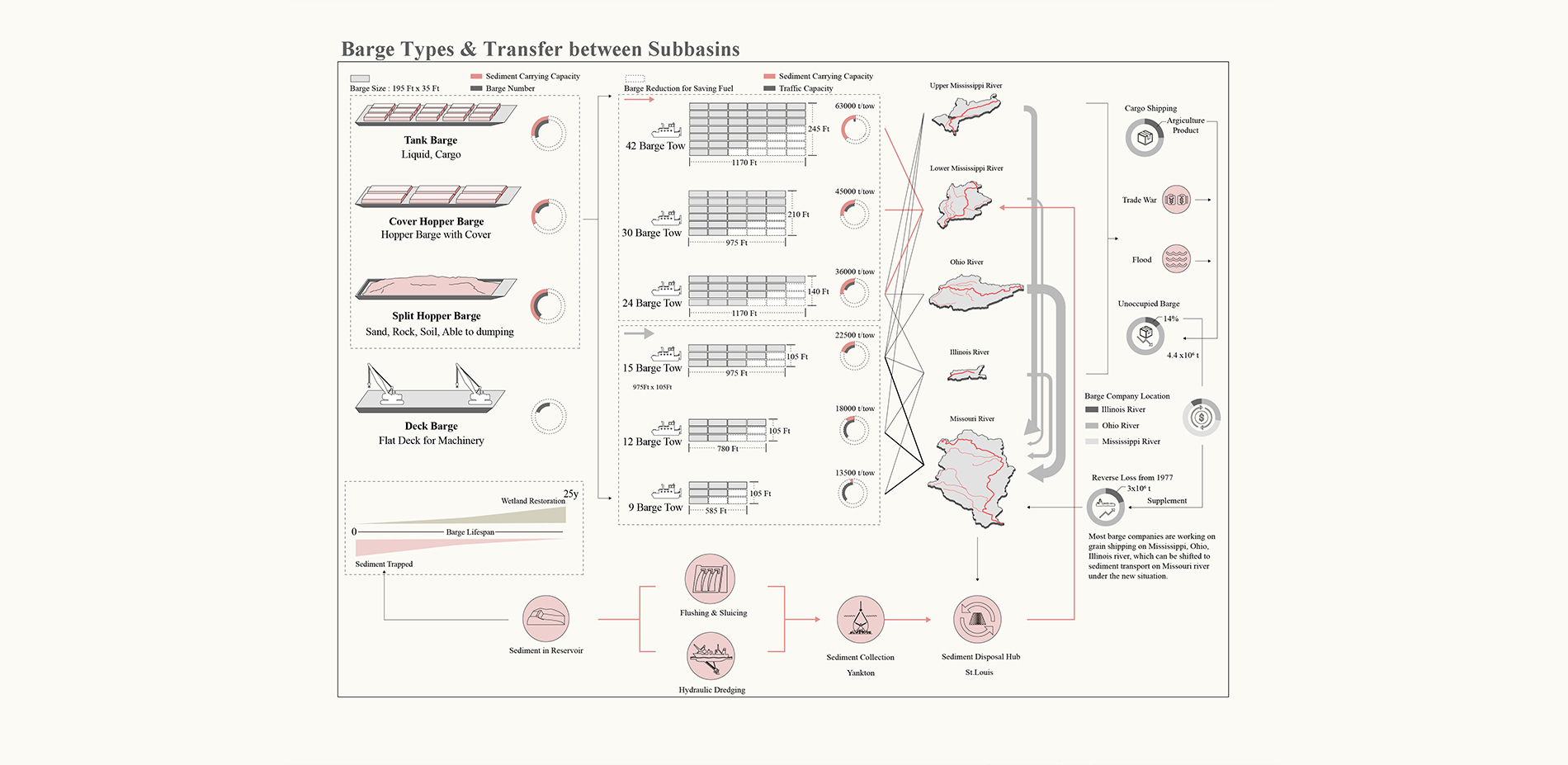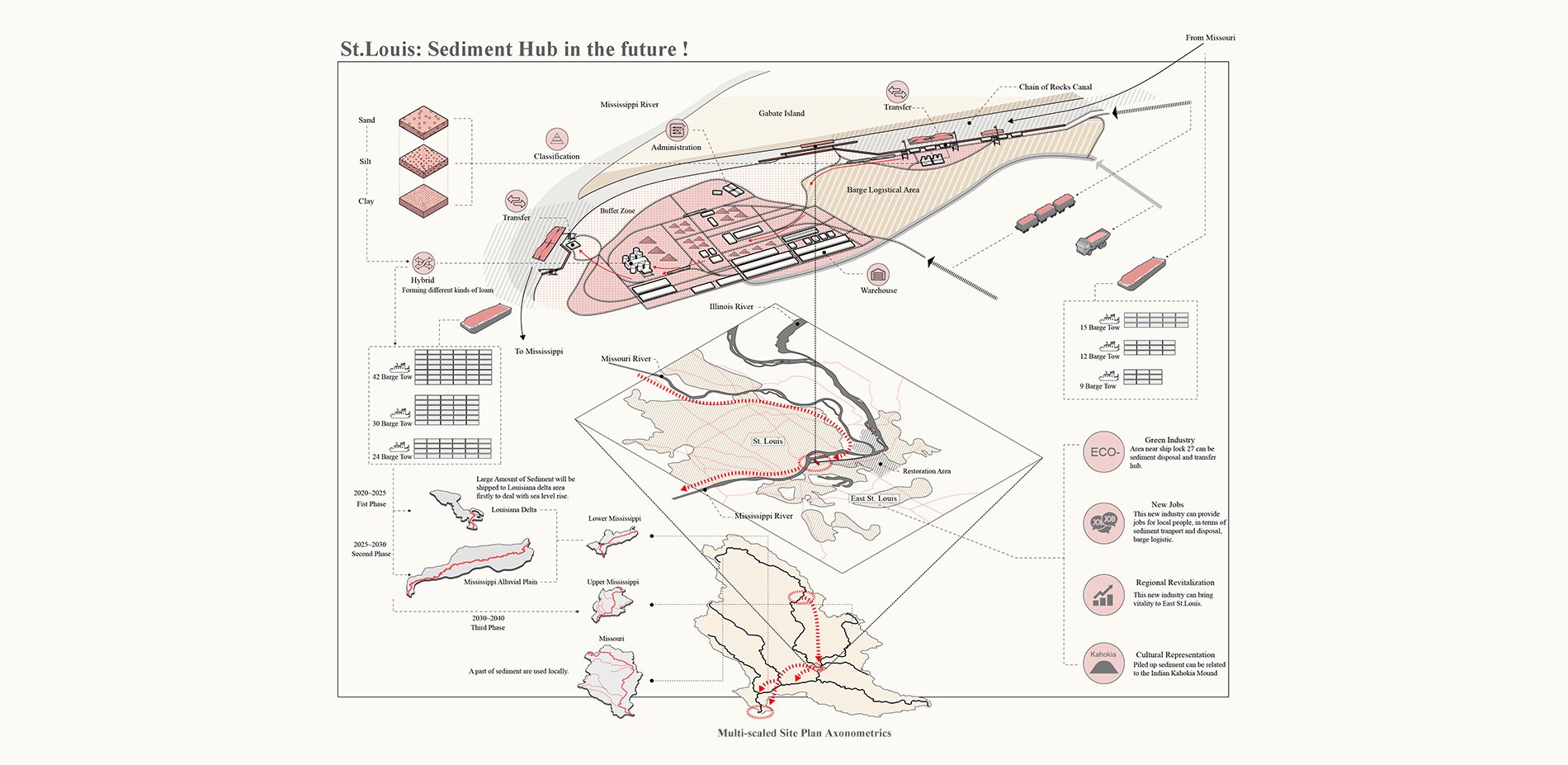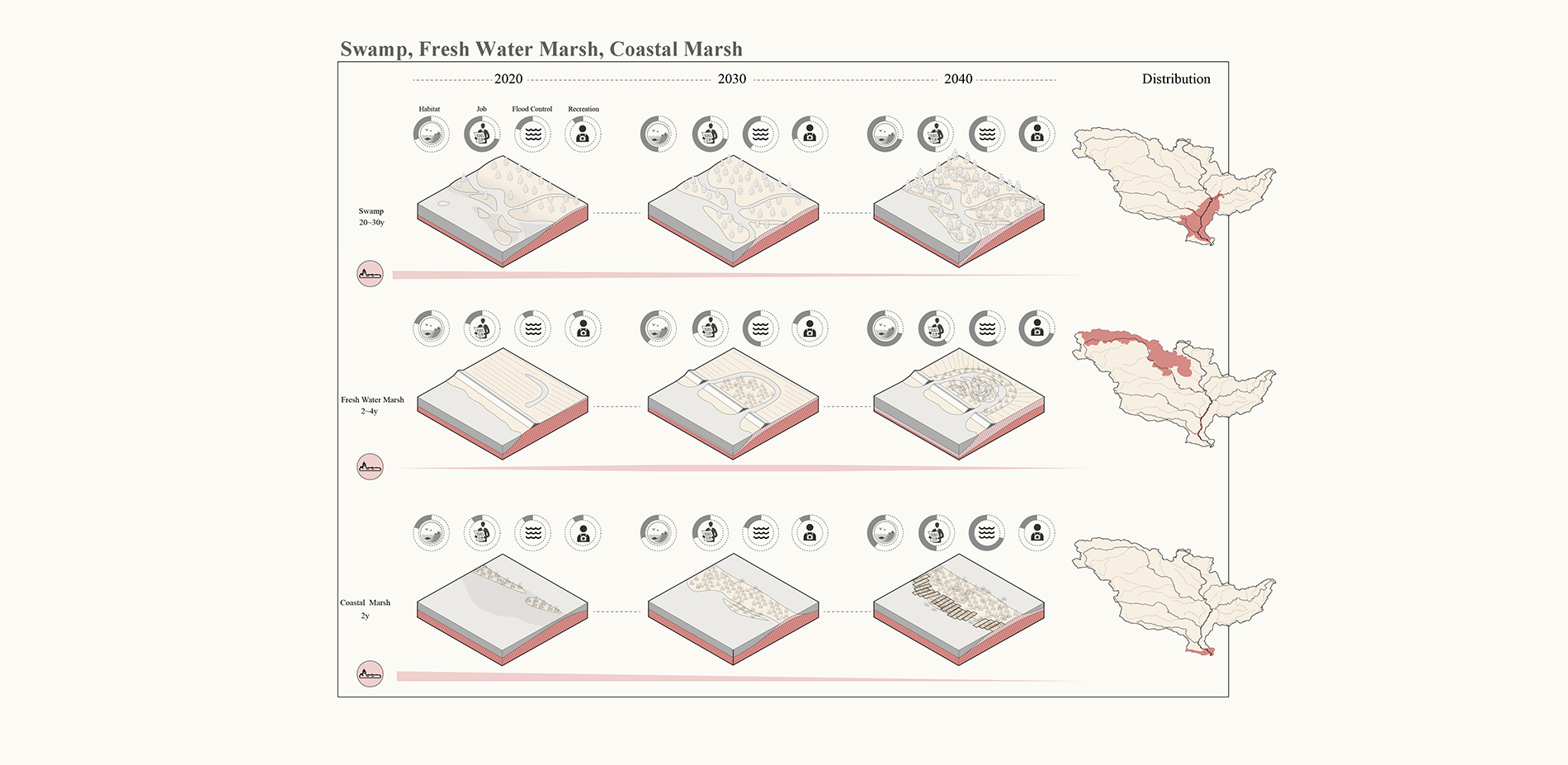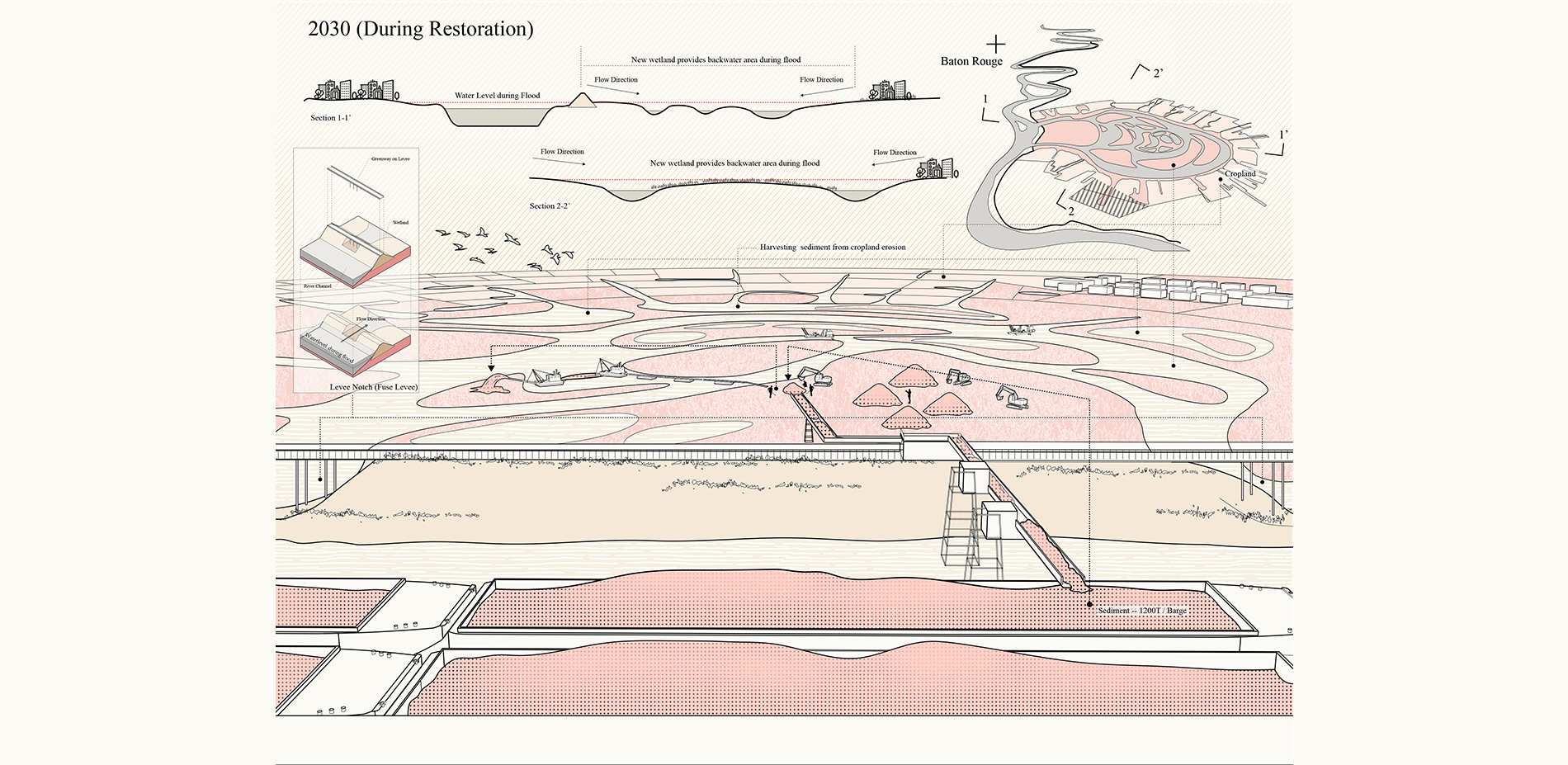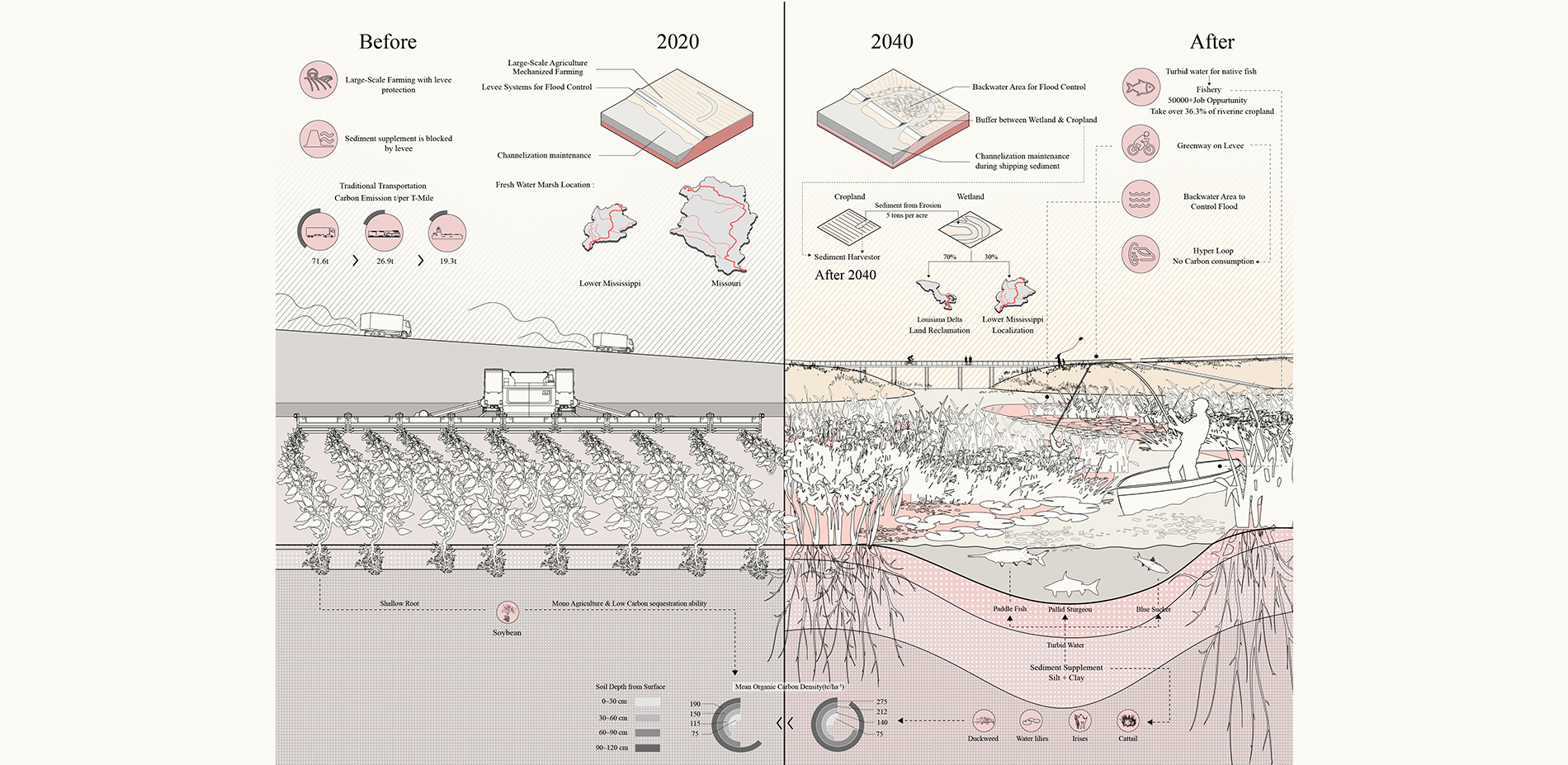The Death and Life of Great American Barges
Honor Award
Analysis and Planning
Mississippi River Basin, United States
Weicong Huang
Faculty Advisors: Derek Hoeferlin, Associate ASLA
Washington University in St. Louis
This project revives the old Mississippi River barge system to revitalize America’s great river, tapping into a ubiquitous, historical object to address the economic and ecological future of a region. There have been many studies of the river that we’ve seen before, but none in this type of detail. The proposal is intriguing and ecological, portraying innovation and smart analysis.
- 2021 Awards Jury
Project Statement
The Mississippi River is the primary navigation and shipping artery of the United States’ heartland, connecting croplands and communities. Throughout the past two centuries, locks and dams were constructed on the Mississippi river to maintain waterways for inland navigation. Levees were constructed to protect croplands and towns, thereby securing economic growth. But this “20th century” mode of development is not sustainable anymore. Due to dams, the free flow of sediment transport in the river has been drastically reduced. Flooding has become one of the major ecological challenges impacting the Mississippi River Basin. The combinations of floodplain developments, bigger levees and the negative effects of climate change lead to flora and fauna deterioration and economic damage to communities. This strategy proposes adapting the barge industry regime to transport trapped sediment to restore riverine wetlands, in turn creating a resilient, ecological, multi-use flood buffer zone along riparian zones and floodplains. The project proposes a compensation mechanism coupled with a step-by-step approach, to tackle emerging environmental issues and help traditional industries transition to a new era.
Project Narrative
Climate change and economic inequality have deep influence on both social and ecological environments globally, especially in recent decades. Because of people’s endless exploitation of resources and land for the development of human society, anthropogenic disasters such as sea level rise, subsidence and flooding and storm surge cast huge shadows on riverine and coastal communities. Social inequality also shifts the harm of these environmental disasters onto people living in disenfranchised conditions. Now, it is the time to call for a more ecological and sustainable development mode for entire river basins. Besides the environmental importance proposed by this project, it is also a response to the call for new infrastructure plans for the United States, as a reasonable option to switch the old riverine development mode to an ecologically based new one. It not only proposes environmental beneficial, but also brings new job opportunities to local communities, which hopefully can help close the social inequality gap in the United States’ heartland.
Dams and levees were designed and constructed for economic or protective purposes on rivers, not just in the Mississippi, but at a globally transferable scale. It is without a doubt, that these facilities, including ship locks, dams and levees benefit riverine economic development at a massive scale, but create negative consequences including severe ecological problems. The Mississippi river and its tributaries, which are now highly engineered with locks, dams and levees, can be seen as a very typical example of such stressors.
In the past 150 years, 29 locks and dams were constructed along the upper Mississippi river and others on its tributaries, such as the Ohio river and the Illinois river. These were continually built to maintain a 9-feet-deep channel for shipping. Some larger dams on the Missouri River, especially the “Big 6 Dams with their correlating large reservoirs -- Fort Peck, Garrison, Oahe, Big bend, Fort Randall and Gavins Point -- are built for electricity power production, irrigation and flood control. These locks and dams severely restrict the free flow of sediment in the river, especially the six dams on the Missouri river, causing a lack of sediment supplement in the lower Mississippi river basin for needed wetland nourishment.
Other common structures along rivers are levees, which have been constructed to maintain the navigation channel, as well as for protecting riverine cropland and urbanized areas from flooding. But the floods are getting larger and frequent in recent years. Devastating floods occurred in 1993, 2011 and 2019, with an unprecedented frequency. The 20th century-designed levees do function well when facing these 21st century-disasters. Many collapse and become overtopped during flood events. This calls for new types of adaptive flood control designs. Furthermore, the construction of levees along river banks can speed up the flow of water, which assist shipping in certain ways but also obstruct sediment from supplementing riverine wetland. The lack of sediment supplement of riverine wetland already causes many ecological issues, such as natural habitat loss for native species. In terms of flood control, wetlands serve as a buffer between cropland or local communities to accommodate parts of the flood water and relieve the stress of levees. Wetlands also serve as habitats for native species and regulate river sediment for native fish, such as pallid sturgeon. But now these wetlands are blocked by levees and deteriorating. Local communities, who live along the rivers have to bear the consequences. Meanwhile, most of interest from inland water transportation goes towards big agricultural corporations., not local communities
These locks, dams and levees negatively impact local and regional ecologies, and of course scale up to global scales economically. As such, this project not only analyzes the functions of locks, dams and the barge industry and their environmental influences on the Mississippi River Basin, it importantly analyzes comparative contexts globally, specifically the Yangtze River Basin. The Yangtze is also a highly-engineered system, and suffers from similar frequent and damaging flood issues as the Mississippi. In order to better understand how the ship locks and dams work and how they influence the ecological environment in the Mississippi River Basin, as well as in other river basins in the world, this project speculates a cooperation with the US Army Corps of Engineers (USACE) for new research and monitoring of locks and dams in the Mississippi River Basin, as well as the Changjiang Water Resources Commission (CWRC) for research on floods and dams on the Yangtze River Basin. After research and analysis, a similarity of problems affect locks, dams and levees in both the Mississippi and Yangtze River Basins, more particularly river bank erosion and trapped sediment behind dams. The proposal on the Mississippi river could be an example for those suffering from the same issues in the world.
There are two direct methods to tackle these issues. One is to tear down the existing structures on the river, and the other is to utilize them to achieve ecological goals. Considering there are still thousands of workers relying on the barge industry to make a living in the Mississippi River Basin and tearing down dams and levees in a short time may cause other environmental and social risks, reusing these structures to achieve ecological and community benefits is the more socially sustainable and resilient option.
Since we do not need to tear down these structures on the river immediately, using barges to transport trapped sediment for riverine and coastal wetland restoration could be an offset for the ecological problems caused by infrastructures built for navigation purposes. The Missouri River provides the majority of the sediment in the Mississippi River Basin and as such, most of the trapped sediment is on the Missouri river, in the massive reservoirs behind the six huge dams. The lack of sediment makes the lower Mississippi and Louisiana coastal area vulnerable to wetland loss. It is necessary to figure out how to relocate the trapped sediment. Compared with other transportation tools, such as train and truck, barges are still the cheapest one and the most ecological one with lower carbon emission. Despite barges still being powered by diesel, hopefully in the future they can be powered by renewables. The sediment transportation can be a new commercial direction for barge transportation, as a new ecologically-based industry. Sediment trapped behind dams are flushed away by regular sluicing of dams and collected in Yankton, the starting point of the shipping channel on the Missouri river. Due to the depth and width of the Missouri river, a barge tow of 9-15 can navigate there. When the tow arrives in St. Louis, the riverine port on confluence of the Missouri and the Mississippi Rivers, the sediment could be classified and reloaded on larger barge tows of 24-42, and transported to the Lower Mississippi River Basin. St. Louis will be a future sediment hub, providing jobs for local communities. The restoration of wetlands, such as swamps and fresh water marshes, along with levee modification in the Lower Mississippi River Basin and other sub-basins will improve environments for natural species and also produce job opportunities, such as wetland management and traditional fisheries. The Louisiana coast will be the last stop of this trip. Restored coastal marshes coupled with abandoned barges can form a defense line over floods. The barge industry can play an important role in river management on the Mississippi River in the next 20-25 years.
Calculating the input and output of this project in terms of finance and carbon balance is also an important part for this project. The cost of sediment transportation is far lower than economic loss on flood events. The environmental output is difficult to quantify but very valuable. In terms of carbon balance, carbon sequestration of restored wetlands per year is far larger than carbon emission of barge transportation per year.
